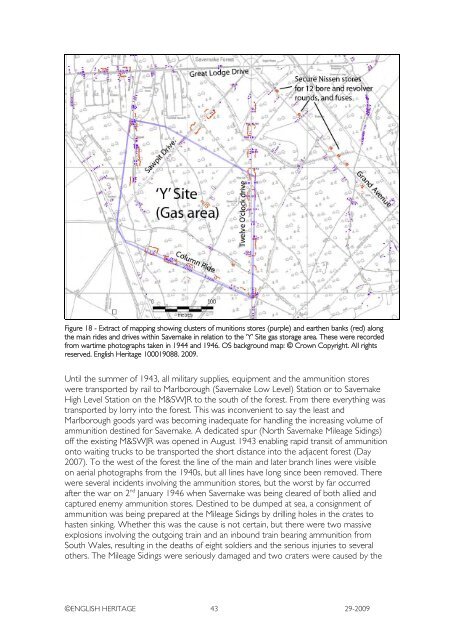savernake forest a report for the national mapping ... - English Heritage
savernake forest a report for the national mapping ... - English Heritage
savernake forest a report for the national mapping ... - English Heritage
Create successful ePaper yourself
Turn your PDF publications into a flip-book with our unique Google optimized e-Paper software.
Figure 18 - Extract of <strong>mapping</strong> showing clusters of munitions stores (purple) and ear<strong>the</strong>n banks (red) along<br />
<strong>the</strong> main rides and drives within Savernake in relation to <strong>the</strong> ‘Y’ Site gas storage area. These were recorded<br />
from wartime photographs taken in 1944 and 1946. OS background map: © Crown Copyright. All rights<br />
reserved. <strong>English</strong> <strong>Heritage</strong> 100019088. 2009.<br />
Until <strong>the</strong> summer of 1943, all military supplies, equipment and <strong>the</strong> ammunition stores<br />
were transported by rail to Marlborough (Savernake Low Level) Station or to Savernake<br />
High Level Station on <strong>the</strong> M&SWJR to <strong>the</strong> south of <strong>the</strong> <strong><strong>for</strong>est</strong>. From <strong>the</strong>re everything was<br />
transported by lorry into <strong>the</strong> <strong><strong>for</strong>est</strong>. This was inconvenient to say <strong>the</strong> least and<br />
Marlborough goods yard was becoming inadequate <strong>for</strong> handling <strong>the</strong> increasing volume of<br />
ammunition destined <strong>for</strong> Savernake. A dedicated spur (North Savernake Mileage Sidings)<br />
off <strong>the</strong> existing M&SWJR was opened in August 1943 enabling rapid transit of ammunition<br />
onto waiting trucks to be transported <strong>the</strong> short distance into <strong>the</strong> adjacent <strong><strong>for</strong>est</strong> (Day<br />
2007). To <strong>the</strong> west of <strong>the</strong> <strong><strong>for</strong>est</strong> <strong>the</strong> line of <strong>the</strong> main and later branch lines were visible<br />
on aerial photographs from <strong>the</strong> 1940s, but all lines have long since been removed. There<br />
were several incidents involving <strong>the</strong> ammunition stores, but <strong>the</strong> worst by far occurred<br />
after <strong>the</strong> war on 2 nd January 1946 when Savernake was being cleared of both allied and<br />
captured enemy ammunition stores. Destined to be dumped at sea, a consignment of<br />
ammunition was being prepared at <strong>the</strong> Mileage Sidings by drilling holes in <strong>the</strong> crates to<br />
hasten sinking. Whe<strong>the</strong>r this was <strong>the</strong> cause is not certain, but <strong>the</strong>re were two massive<br />
explosions involving <strong>the</strong> outgoing train and an inbound train bearing ammunition from<br />
South Wales, resulting in <strong>the</strong> deaths of eight soldiers and <strong>the</strong> serious injuries to several<br />
o<strong>the</strong>rs. The Mileage Sidings were seriously damaged and two craters were caused by <strong>the</strong><br />
©ENGLISH HERITAGE 43 29-2009

















